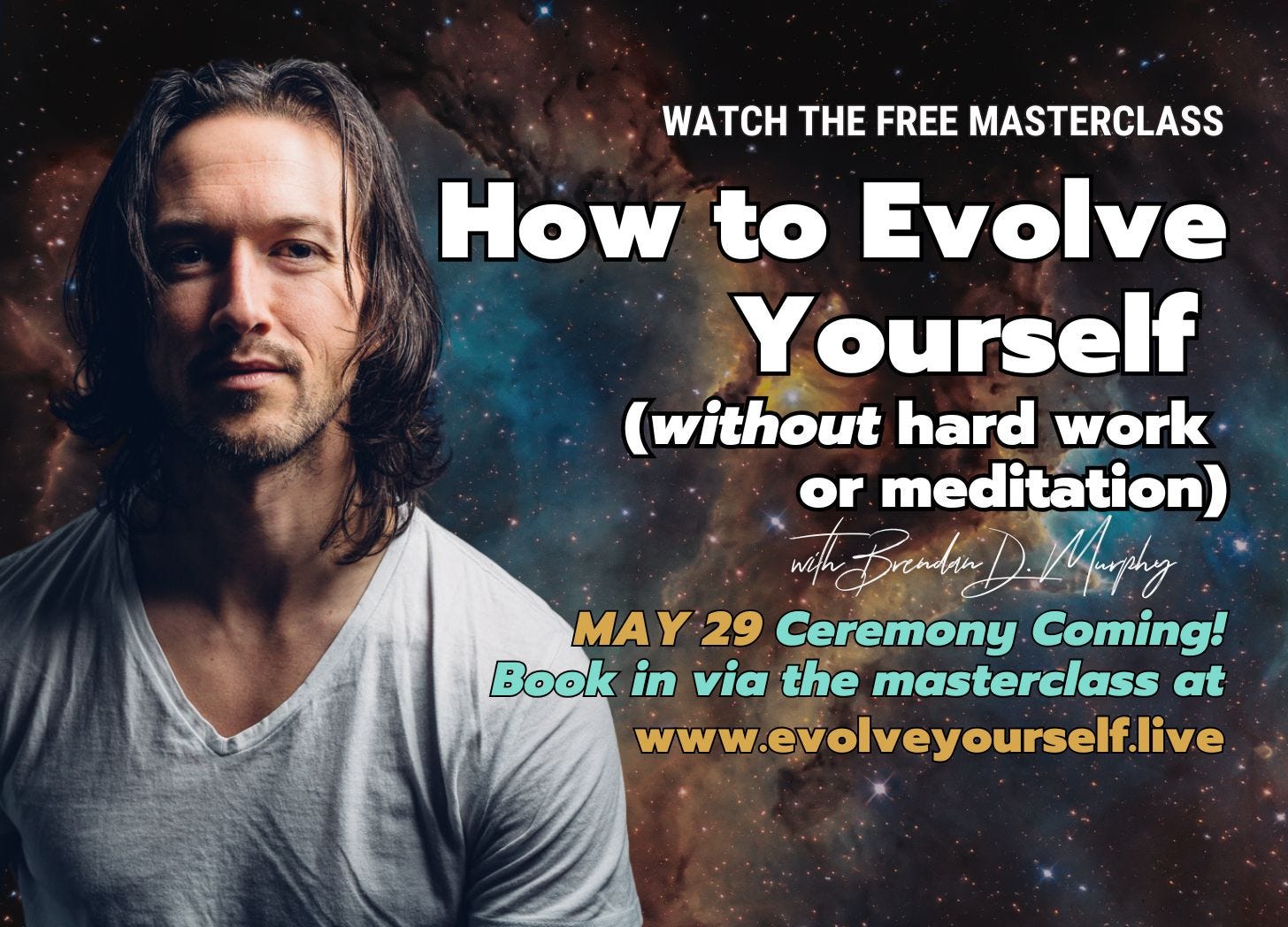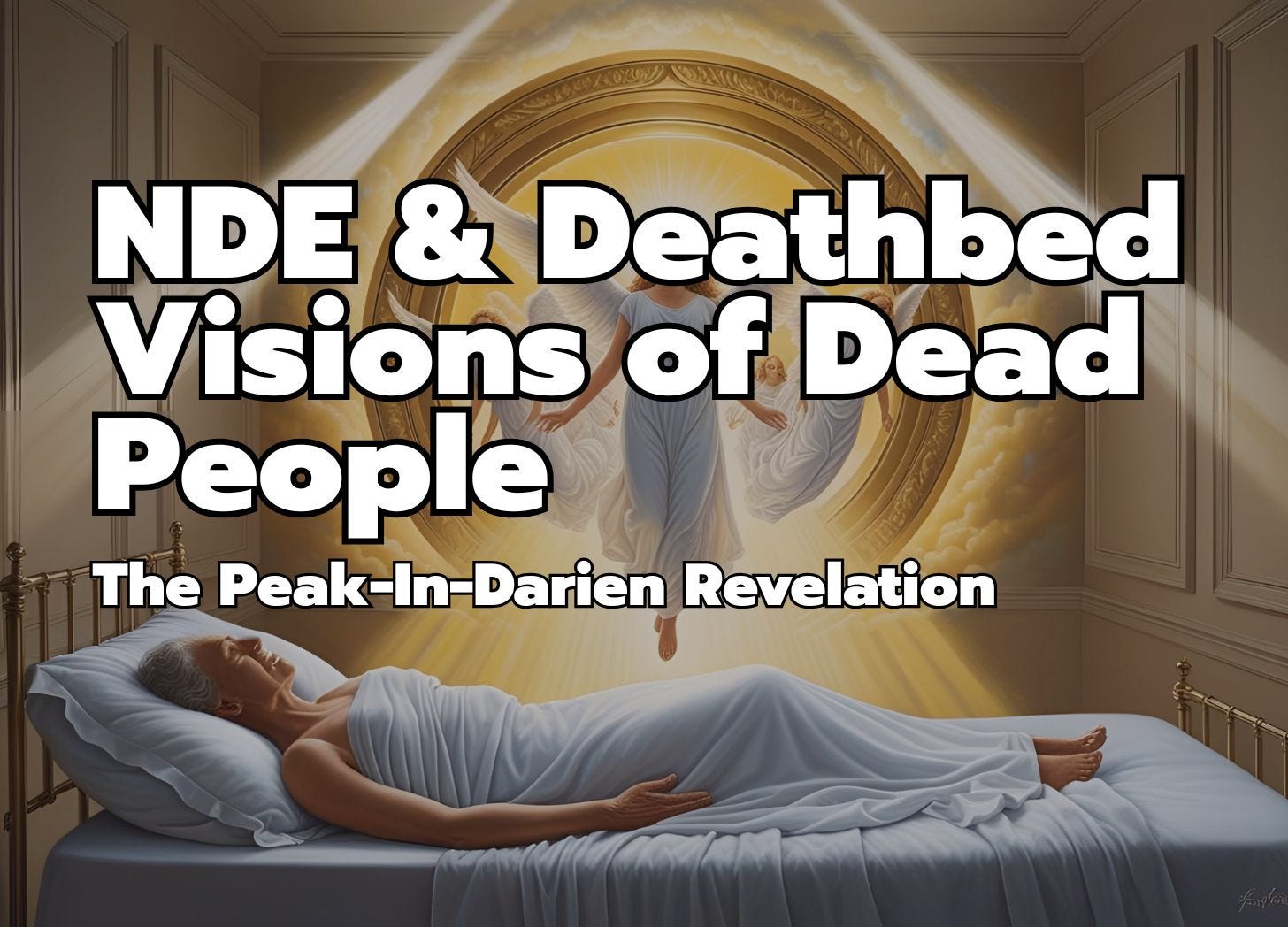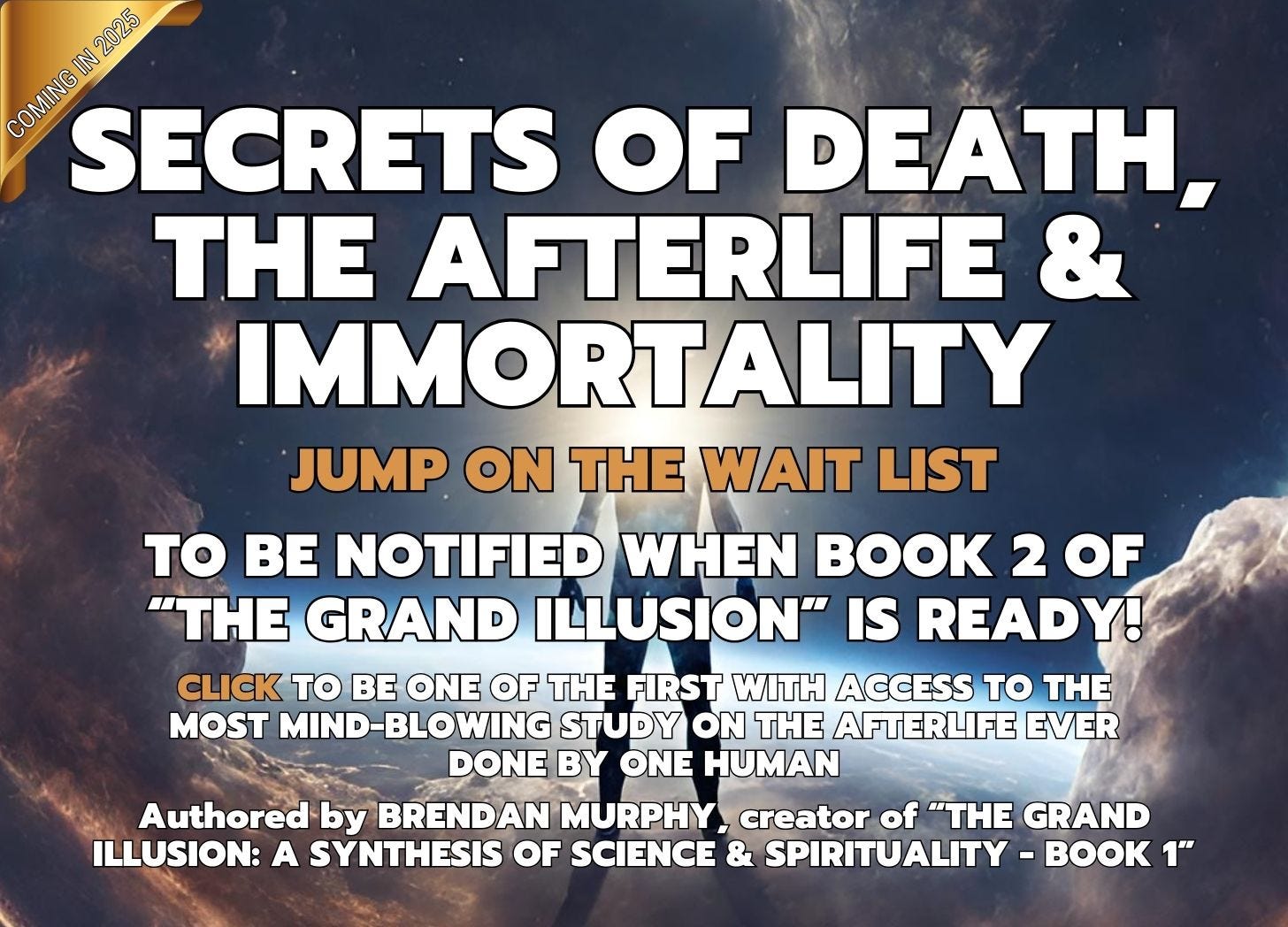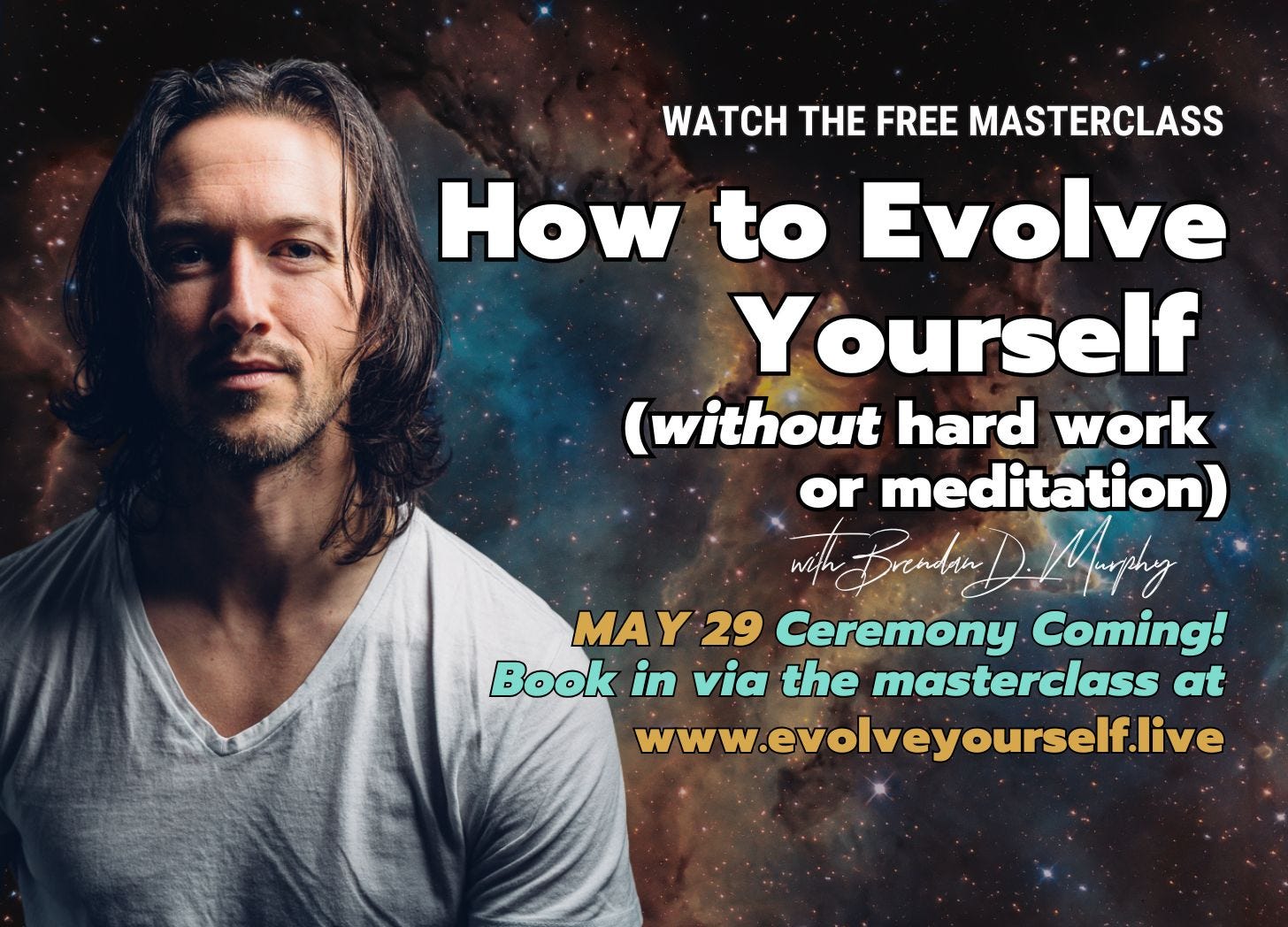Thanks for reading AWAKENING MINDS! Other ways I can support you (and vice versa) ⤵️
⚠️ NEW LIVE CEREMONY: May 29th! Discover the life-changing and consciousness-expanding ➡️ EVOLVE YOURSELF biofield activations
Through my first book, THE GRAND ILLUSION: A SYNTHESIS OF SCIENCE & SPIRITUALITY - Book 1 📘 - 10,000 hours of research in 1 book
With a paid Substack subscription to get FULL Substack access (includes all audio 🎧 versions + comments on all pieces)
Thanks in advance for supporting.
Visions On the Deathbed
Medical professionals such as nurses and physicians have, over decades, provided a rich database of “anomalous” experiences connected to dying individuals. In Book 2 I weave this data into a much bigger-picture perspective.
Our focus here in this piece will be on documented cases where someone had a near-death experience (NDE) and perceived in their vision an image of someone else they never knew existed, or someone who had recently died unbeknownst to them.
In one case, a woman who was in the last seconds of her life looked up and in the presence of witnesses said, “There’s Bill, he is calling me in a clear, loud voice,” and then passed away. Bill turned out to be her brother who had died the week before...and she had never been informed of the death.12
In yet another such case, a dying woman spoke of seeing three of her brothers, each long since dead—though she also recognised a fourth brother in her vision, a brother who was thought to still be living in India. A while later, the family received letters from India announcing the death of the fourth brother, who had died before his sister’s deathbed vision. Philosopher Michael Grosso comments that, “Everything looks as if the fourth brother died, joined his three dead brothers, and that all together they escorted their dying sister into the next world.13”
Similar such cases occur with children and their siblings whose deaths had occurred so recently that they had not yet been availed of the sad news. There are also cases of deathbed visions that were shared and not just experienced by one person alone.
Dr Karlis Osis’ extensive study of the death-bed observations of physicians and nurses from 1961 was a monumental study of the dying, based on a large questionnaire survey.
10,000 questionnaires about death-bed observations were sent out, half of them to physicians and half to nurses. On the less than 700 surveys that were actually returned, detailed analyses were performed—in all, some 35,000 deathbed observations had been reported. The results were published by Osis in Deathbed Observations by Physicians and Nurses.
Osis found that about 10% of dying patients appeared to be conscious in the hour preceding death. Surprisingly enough, fear was not the dominant emotion in these individuals…discomfort, pain, and even indifference were more frequent. It was estimated that about one in twenty dying persons showed signs of elation.
A surprising finding in this research was the high incidence of visions with a predominantly nonhuman content. They were approximately ten times more frequent than one would expect in a comparable group of persons in normal health. Some of these visions were more or less in accordance with traditional religious concepts and represented heaven, paradise, or the Eternal City; others were secular images of indescribable beauty, such as landscapes with gorgeous vegetation and exotic birds. According to the authors, most of these visions were characterized by brilliant colors…The main focus of this study was on hallucinations of dying individuals involving human beings.
Osis was able to support Barrett’s and Hyslop’s hypotheses that dying individuals predominantly hallucinate phantoms representing dead persons, who often claim to aid the individual’s transition into post-mortem existence. He also confirmed the apparitional nature of these hallucinations, since a large majority of patients experienced them in a state of clear consciousness…Most dying individuals were fully conscious, with adequate awareness and responsiveness to the environment. This study also demonstrated the relative independence of the characteristics of these hallucinations from physiological, cultural, and personality variables.
The roots of this type of experience seemed to go beyond the personality differences between the sexes, beyond physiological factors such as clinical diagnosis and type of illness, and beyond educational level and religious backgrounds. Hallucinations of dead people involved mostly close relatives of the dying individuals; visions of nonrelatives usually represented living persons.14
Also worthy of note was the finding that most visions (76%) tended to occur within the last hour of life.15
Patterns matter: this particular pattern is evidence in itself that something truly interesting is happening which has nothing to do with chance.
Osis later undertook a second survey, this time collaborating with Erlendur Haraldsson (now known simply as Erlendur), a psychologist and parapsychologist from the University of Reykjavik, Iceland. They travelled to northern India to survey a large number of medical personnel and found that death-bed visions follow the same general pattern as in the West. Most of the 471 incidents occurred within twenty-four hours of death and were of deceased relatives and friends who the patients perceived—often joyfully—as coming to “take them away.”16
The two primary differences between the two studies were that people dying in India more commonly reported seeing religious figures coming to escort them into death, and they were, on average, more fearful of these visions than people in the West.17
To summarise, Osis and Erlendur found that,
Most dying people report seeing familiar people who are already deceased.
Very often the friends and relatives in these visions express directly that they have come to escort them into the afterlife.
The dying person is reassured by the experience and expresses great contentment or happiness with the vision.
The dying person’s mood and even state of health improves until death occurs.
Experiencers don’t seem to be hallucinating or to be in altered states of consciousness—they are lucid and aware of their surroundings.
Belief (or non-belief) in an afterlife does not predict deathbed visions—experiences and reactions are basically the same regardless (they do not result from preconceptions or conditioned wish fulfilment).
In deathbed visions, discarnate relatives often appear with a being identified as an “angel” to escort the dying person into the hereafter.18
While deathbed visions are not NDEs as such, they do point to survival of consciousness and should be considered as part of the wider parapsychological tapestry relating to survival.
The late parapsychologist D. Scott Rogo pointed out that deathbed visions differ from NDEs in two primary ways: the dying patient is typically lucid and physiologically functional when the vision happens and reports it in real-time, and their consciousness is very much experienced as “in the body”19 (they are not reporting on an OBE form of perception).
The first book published pertaining to deathbed visions appears to have been Daisy Dryden—A Memoir (1864). This little pamphlet documented ten year old Daisy Dryden’s deathbed visions of her brother, “Jesus” (she was the daughter of a Methodist minister), and “angels” whose appearance surprised her because they did not have wings and looked like normal people. Her deceased brother Allie also visited and Daisy communicated telepathically with him, “with our think” as she put it. Her contact with the other side left her utterly at peace with the knowledge she was to die and be escorted into the afterlife by her brother.20
The Peak-in-Darien Revelation
In 1882, with the historical formation of the Society for Psychical Research approaching, Frances Power Cobbe published Peak in Darien—With Some Enquiries Touching on Concerns of the Soul and Body, which contained a small section on deathbed visions. Cobbe made the revelatory observation—possibly the first person to do so—that dying people sometimes have visions of deceased friends or relatives who they didn’t know were dead.21 (These became known as “Peak-in-Darien cases.”)
Though Cobbe’s study was flawed and limited, it did spur other early psychical researchers to seek out similar cases and study them more meticulously, including Revered Minot J. Savage a Boston minister who wrote actively on psychical research in the last decade of the 19th century and into the first decade of the 20th.
One of his striking “Peak-in-Darien” cases involved two young friends aged around eight (one slightly older than the other) who both developed diphtheria in 1889. Jennie died on a Wednesday at noon. Her parents and doctor made a diligent effort to prevent little Edith from discovering that her playmate had died—and they succeeded. On the Saturday evening before she too died, young Edith reported seeing various friends who she had known were dead, but suddenly turned to her father and said, “Why, papa, I am going to take Jenny with me! Why did you not tell me that Jenny was here?” Reaching out her arms to welcome her friend now in spirit, she exclaimed, “Oh Jennie, I’m so glad you are here!”
Shortly thereafter, Edith too departed for the spirit world.22
Instances like these serve to demonstrate that “anomalous” deathbed visions do qualify as valid psychological events involving veridical/accurate information hitherto unknown to the dying individual—even more so when they are shared by a second person (or more).
Sir William Barrett and Edmund Gurney, to name two investigators, collected several such cases. Some involved the perception by multiple people of heavenly music in the room of the dying (or newly dead) individual. Italian paranormal investigator Ernesto Bozzano published several such reports in 1923 in Phenomenes Psychiques au Moment de la Mort. Dr James Hyslop considered these events to be key in the argument for survival (for obvious reasons). In two of the cases featured in Barrett’s Deathbed Visions, the sound of the music is compared by witnesses to an aeolian harp—and other cases describe beautiful, sweet voices singing.
Rogo made the salient observation that beings in the “spirit world” may be alerted to the fact that someone they are connected to is about to transition (permanently), and thus, be there to meet them on the threshold so to act as a guide into the hereafter, whereas in cases of clinical or temporary death this “call” would not happen and the NDEr thus crosses into the afterlife (only briefly) before meeting these familiar beings—only to be told it’s not their time to die, at which point they are sent back to earth.
There are documented occasions where children have pre-sensed their deaths well ahead of time, with one fifteen-year-old girl stating matter-of-factly to her mother that her declining school grades did not matter because “my life is almost over.” She spent a couple of days ironing her clothes and tidying her room for her mother and fulfilled her own prophecy by thereafter dying in a car accident for which she was not responsible. A passage found in the teen’s diary encouraged her mother to self-heal the pain she felt.23

Psychiatrist and pioneer in near-death studies, Elisabeth Kubler-Ross found that, regardless of race, numerous children who claimed that someone was waiting for them on the other side had mentioned a person who had preceded them in death, despite none of the children having been informed of that person’s death.24 Kubler-Ross is a 2007 inductee into the National Women’s Hall of Fame and was the recipient of twenty honorary degrees. By July 1982 she had taught, in her estimation, 125,000 students in death and dying courses in colleges, seminaries, medical schools, hospitals, and social-work institutions.25
The 1889 Census of Hallucinations by Henry Sidgwick and his collaborators revealed strong correlations between many “hallucinations” and real world events—including a number of shared events. 17,000 people were surveyed of which 1,684 responded claiming to have seen apparitions.26
In one instance, a group of eight people in a family home were interrupted by the pet dog suddenly and inexplicably barking loudly and staring toward the stove. When the group turned, they were met with the sight of a boy around the age of five, wearing a t-shirt. They recognised him as Andre, the local milkman’s son. Later that same day, the group learned that Andre had died in another part of town at the very time they witnessed his appearance in the house. The dog had even followed his form around the room.27
Some cases involving deathbed visions also feature other elements such as visitation by the astral double, and “heavenly” music. A case from 1879 cited by William Barrett in Deathbed Visions involved a mother and her two young girls, Minnie and Ada, eight and nine, respectively. The mother and daughters had been visiting her sister-in-law in the country while in the process of securing a new family home. Having bought the new home near London, the mother sent the two girls there with their nurse by train, following several hours later. Sadly, that evening both girls suddenly became ill and were diagnosed with severe smallpox—and both died within the week. Minnie transitioned first.
The day after Minnie was buried, the bereaved mother was watching with resignation Ada’s last hours. Suddenly the sick child woke up from a kind of stupor, and exclaimed, “Oh, look, Mamma, look at the beautiful angels!” pointing to the foot of the bed. Mrs. G. saw nothing, but heard soft sweet music, which seemed to float in the air. Again the child exclaimed: “Oh, dear Mamma, there is Minnie! She has come for me”; she smiled and appeared greatly pleased. At this moment Mrs. G. distinctly heard a voice say, “Come, dear Ada, I am waiting for you!” The sick child smiled once again and died without a struggle.28”
There is more, however: on the evening of the very day they left the sister-in-law’s home for London—the same evening the girls became ill—one of them walked into the room of the house they had left that morning (a physical impossibility), “where a cousin to whom she was much attached was sitting at his studies, and said to him, ‘I am come to say good-bye, Walter; I shall never see you again.’ Then kissing him she vanished from the room.29”
It appears the very startled Walter was visited by the physicalised “soul” of the sick young girl in London.
The late reincarnation researcher Dr Ian Stevenson coined the term “idiophany” to refer to such un-shared “paranormal” perceptions which conveyed verifiably accurate information.30
In Dr Bruce Greyson’s excellent 2010 article on Peake-in-Darien cases, he provides, among other fine examples, one from hospice nurses Maggie Callanan and Patricia Kelly. They documented the story of a 93-year-old Chinese woman who was dying of cancer and having recurrent visions of her deceased husband calling her to join him.
One day, much to her puzzlement, she saw her sister with her husband, and both were calling her to join them. She told the hospice nurse that her sister was still alive in China, and that she hadn’t seen her for many years. When the hospice nurse later reported this conversation to the woman’s daughter, the daughter stated that the patient’s sister had in fact died two days earlier of the same kind of cancer, but that the family had decided not to tell the patient to avoid upsetting or frightening her.31
When the daughter revealed to her elderly dying mother the truth about her sister passing away two days earlier, she relaxed and transitioned peacefully not long thereafter.
Dr Pim van Lommel provides a Peak-in-Darien case in his book Consciousness Beyond Life, wherein a five-year-old girl had an NDE due to meningitis. Entering a safe, black void she encountered a girl who appeared about ten years old. They hugged and the girl told her, “I’m your sister. I died a month after I was born. I was named after your grandmother. Our parents called me Rietje for short.” Rietje gave her a kiss and said, “You must go now.”
After awakening in her body, the child NDEr drew a picture of her “angel sister” and repeated everything she had told her. The child’s shocked parents confirmed they had lost a daughter called Rietje to poisoning a year before she was born, but had never told her because they were waiting until she was old enough to grapple with the concept of death.32
Even the consciousness inhabiting a fetus can have a full blown trauma-induced OBE, witness events outside the mother’s body, and thus retain pre-birth memories which can then be recalled years later—this too has been documented. Even the children of failed abortion attempts (or even just children whose mother had thoughts of aborting the foetus) have been known to ask their shocked mothers why they tried to kill them when they were in the womb, despite this never having been mentioned to the child before.33 Other children present with traumatic memories ostensibly belonging to the previously aborted baby.34
Miscarriages are recalled too. One girl (Elizabeth) aged seven stated bluntly, “I remember the miscarriage, Mom. That was me. I was a boy, and you and dad had a fight. I chose to leave and come back as girl.” As it happened, the fight was over the issue of circumcision and the father did not grasp the importance of avoiding birth trauma. The miscarriage happened the very morning after the fight. Prior to this, even younger and with less language mastery, the same Elizabeth stated un-prompted: “Oh, yeah, Mom, I was in your tummy twice. The first time I washed away.” The miscarriage had never been mentioned to her.35
When psychologist Dr David Chamberlain began reporting his patients’ memories of birth to his colleagues he was rebuked with the belief that such memories “were impossible because the myelination of nerve tracks was not complete at birth and therefore signals could not flow properly through the nervous system. The truth is that myelination begins in some places only a few weeks after conception but is not completed until adolescence. It is no measure of what a baby’s brain can do.”36
In landmark research with mother-child pairs in 1980, Chamberlain demonstrated that birth memories (if not pre-birth memories) were indeed reliable37.
Overall, in the bulk of NDEs, the vast majority of people/spirits encountered are deceased, and as we have noted, they are not always known to have been deceased (Peak-in-Darien cases).

One recent and exceptional Peak-in-Darien report came from a woman who went to bed one night to suddenly awaken in what seemed like a “massive airplane hangar” of some sort. Surprisingly, her husband—who was out of town visiting family—was there too:
We spoke without speaking, telepathy style. So much was said and loose ends, such as a dance we never finished from years before, was finished. There was such a feeling of perfect love and peace…Yet I felt he was saying goodbye, which I couldn’t understand.
In this realm the two of them relived a number of shared past events, as if sharing a sort of life review:
it was as if instantly transported to that scene, in a different area of the “hangar.”…We ended up at the beach, only that’s the time I noticed things weren’t as in daily life…it was like an immersive illusion, yet it was tangible: the ocean breeze, salty smell and sea spray, but a kind of perfect…physical sensation. It was here he hugged me and my spirit grasped that he was saying goodbye.38
In the morning, she received a call from her husband’s sister: he had died, apparently while—or close to the time—she had the “dream” experience with him. This report captures well the hyperreality of the shared “astral”/imaginal dreamscape environment, with the experiencer even using the term “immersive illusion.”
A holographic consciousness construct—shared, in this instance.
What the Numbers Tell Us
Emily Kelly (2001) studied 274 NDEs from the larger pool of the University of Virginia’s database (553 NDEers at the time). 200 of these did not feature encounters with other beings, while 74 did. Only 4% (11) of the 274 people reported seeing living people they knew at the time—by far most beings encountered in NDEs were deceased or others unknown. In 2010 the collection had grown to 665 NDEers, and Greyson (also University of Virginia) reported 138 (21 percent) included a purported encounter with a deceased person, whereas only 25 (4%) included a purported encounter with a living person.39
Bottom line: People having genuine NDEs tend not to “hallucinate” the living.
In Osis’ and Erlendur’s monumental study, they found, in contrast, that when familiar people are present in dreams or hallucinations they are much more likely to be both alive and from recent memory. Thus there is apparently a reasonably clear point of distinction between NDE visions and the beings who appear in dreams or hallucinations.
It is true, however, that there are a number of intriguing cases involving children (more so than adults) that feature apparent NDE encounters with people who are still very much alive and well, as well as fictional beings such as cartoon characters. This suggests to Anthony Peake that “some NDEs are more like dreams than actual incidents.”40 This dichotomy may be a bit simplistic, however—the imagined dividing line between “actual” incidents and pseudo-NDEs may be blurrier than generally appreciated.
Children, interestingly, are also more prone to being accompanied by—or encountering—animals instead of people.41 We can speculate this may be due to the “tailor-made” nature of NDEs, the need-serving nature of NDEs in general: children may find the presence of a cuddly lamb or dog, for instance, to be highly comforting during the altered state of consciousness of the NDE.
Thus, several explanations are possible: the animals (and/or cartoon characters) may be unconsciously conjured thought-forms; the animal consciousness may genuinely be present; some other consciousness may present itself in an animal form. (Born-again fundies would no doubt insist with zeal that it’s all actually a devilish deception. Yawn.)
Erlendur would further report (1989) on Iceland’s experience with sensing the presence of the deceased:
There has been an increase in Iceland in reporting contact with the dead as 31 percent did so in 1975 and 41 percent in 1983…[A] similar increase, using the same item, has also been found in USA. In 1973, 27 percent reported having felt “really in touch with someone who had died.” 30 percent did so in 1981, and 42 percent in 1987.42
The apparent ongoing increase would seem to support contactee Whitley Strieber’s speculation that there has been an increased effort on the part of souls in the “spirit world” to bridge the physical and non-physical realities.
In the 1989 study of 127 experiencers Erlendur interviewed, the final analysis included only cases in which a direct experience of a dead person was reported to have occurred in a waking state, leaving him with 100 such waking state cases. Significantly, of those 100 waking events, the spectral visitor’s identity was recognised by the witness/es seventy-four times. Fifty-nine of the original 127 (46%) respondents reported visual contact; twenty-four auditory; seven tactile; five were olfactory; one person sensed cold.
Erlendur commented:
It has been theorized that apparitional experiences are most likely to occur when external stimulation is minimal. This found little support…since forty-four of our interviewees reported experiencing apparitions in daylight or full electric light, twenty in semidarkness, and only nine in darkness. It has also been theorized that apparitional experiences tend to occur when a person is resting or in a drowsy state [slower brainwave states approaching meditation or dreaming]. There was more support for this view. One third of the interviewees were resting, sitting, or lying in bed, and another third had just awakened or were on the point of going to sleep [hypnopompic and hypnogogic states]…Still, one-third reported having been physically active, working, or going about their daily activities.43
Perhaps surprisingly, about three quarters of the episodes occurred with open, awake eyes. Additionally, 62% of those surveyed were not experiencing grief at the time, which undercuts the shallow idea that these experiences are all simply “grief-triggered hallucinations.”44
In seventy four of the cases the sensed being was identifiable to the percipient. Sixty-three (77%) of the ghostly visitors were males, versus only nineteen (23%) of females. A disproportionately high percentage (23%) of these visitors had suffered violent deaths, way above the national average of 8% for Iceland overall, though
comparable to the findings of the early British researchers who found that 27.5 percent of the agents [“ghosts”] had died violently. The high percentage of agents who suffered violent deaths is in line with a popular belief found in many countries that persons suffering violent deaths tend more frequently than those dying from disease to be involved in apparitional experiences. Psychical research has also shown that alleged deceased communicators through spiritistic mediums have frequently died violently, and children claiming memories of a past life also frequently report having died by accident, murder, or suicide. The predominance of male figures is to some extent explained by the fact that 83 percent of the agents who died violent deaths were males.45
Importantly, forty-three of Erlendur’s cases had another person present as a witness, and thirteen of those reported sharing the experience of sensing a discarnate presence, also a similar percentage to that derived by the early British researchers. Five of Erlendur’s cases were actually crisis apparitions where the witness/es did not know the discarnate being had just died or was about to (either side of a twelve hour window); thirteen cases involved a percipient who had no idea the agent/“ghost” had already died. Osis and Erlendur’s joint work with terminal patients found most experiences happened within twenty-four hours of death.46
Kelly found in 2001 that, of her 553 NDE cases, 74 (13%) featured deceased people, which falls between the 8% reported by Ring in 1980 and the 39% reported by the Fenwicks in 1995. Only two people of Kelly’s 274 reported seeing pets.
Another significant finding was the relevance of actually being close to death and the increased chances of encountering spirits: “among 130 people who were close to death, 28 (22%) encountered a deceased person, whereas among 107 people who were not close to death, only 9 (8%) encountered a deceased person.”
This trend is in line with Osis’ and Erlendur’s findings and supports Rogo’s view that there is indeed a dynamic playing out that involves “souls” on the other side of the veil becoming aware that someone of significance to them is about to make the transition and reaching out to them. Kelly also noticed a correlation between seeing a light and seeing deceased people. 89% of those who saw deceased people “also reported seeing a bright light, an incidence significantly higher than that among participants not seeing deceased persons.47”
Kelly and Greyson were both drawing on the University of Virginia’s NDE database for these reports. As of 2020 it included 1,008 experiencers, “although,” Greyson informed me, “not all of them have answered all questions.”
Out of 711 NDErs who answered a question about whether they met in their NDEs persons not physically present, 461 (65%) answered yes.
43% of respondents said they met deceased persons in their NDEs, and 9% said they met a living person.
Additionally, 40% reported meeting in their NDEs a person they could not identify, and 39% reported sensing a presence without actually seeing anyone.48
Stevenson, Cook, and Owens had previously shown the light in NDEs was reported more frequently when people were actually physically near death as opposed to not.49 Thus, a clear NDE tapestry of interwoven elements exists, an identifiable pattern that strongly favours survival.
Further thwarting the claim of “sceptics” that NDErs simply hallucinate who they most want or expect to see when they die is the simple fact that often the beings who do greet them may be either completely unexpected or even totally unknown to them. In 32% of Kelly’s sample, the encountered being had either a poor or distant relationship with the NDEr, or was someone that had died before the NDEr was born and had never known them.50
As she points out, the "expectation hypothesis” is strained (to put it politely) in trying to account for instances where the NDEr meets someone they neither know, expect, nor long to see. Some NDErs get the surprise of their life (or should we say death?)!
The only medical paradigm that any of this material could fit into is Era III—the “metagenetic” paradigm (as formulated by Dr Larry Dossey) which places consciousness at the font of reality, and the matrix in which all phenomena are born and exist (which, as any mystic worth the title knows, is exactly the case).
Continued in Book 2.
About Brendan & His Other Offers
Brendan D. Murphy is the “consciousness guy” and author of the critically acclaimed epic, “The Grand Illusion: A Synthesis of Science and Spirituality — Book 1”

Get on the wait list for the astonishing Book 2 of “The Grand Illusion”
Entrepreneurs Only > “FREEDOM ON TAP”: Discover a leveraged, highly automated way to build income online: free 90 minute training (watch it in one go and right to the end, as your place in the video won’t be saved if you close the tab or window).
🧬 LEAVING SOON! ➡️ Watch the FREE How to Evolve Yourself (WITHOUT Hard Work or Meditation) Masterclass to learn about Brendan's potent evolutionary biofield activation and healing work with sound. This offer will likely be ended for good in 2025.
*Complete citations and endnotes will be found in Book 2 of “The Grand Illusion”
12 Bushby, 52.
13 Grosso, Experiencing…, 34-5.
14 Grof, The Human Encounter…, 136-8.
15 Rogo, 66.
16 Haraldsson citing K. Osis and E. Haraldsson, At the Hour of Death, 2nd Edition, Hastings House, New York, 1986, in Haraldsson, Survey of Claimed Encounters with the Dead. OMEGA - Journal of Death and Dying, 19(2), 1989. 103–113. doi:10.2190/nuyd-ax5d-lp2c-nux5
17 Rogo, 67.
18 See Heathcote-James.
19 Rogo, 46.
20 Ibid., 47-9.
21 Ibid., 49.
22 Ibid., 50.
23 Bushby, 59.
24 Bushby, 63.
25 http://en.wikipedia.org/wiki/Elisabeth_K%C3%BCbler-Ross
26 https://www.encyclopedia.com/science/encyclopedias-almanacs-transcripts-and-maps/census-hallucinations
27 Grosso, Experiencing…, 28-9.
28 Barrett, Deathbed Visions, 46.
29 Ibid.
30 Greyson, Ian Stevenson’ Contributions to Near-Death Studies, Journal of Scientific Exploration,. Vol. 22, no. 1, pp 54-63, 2008.
31 Greyson, Seeing Dead People Not Known to Have Died: “Peak in Darien” Experiencesanhu_1064 159, Anthropology and Humanism, Vol. 35, Issue 2, pp 159–171
32 Van Lommel, Consciousness Beyond Life, 72.
33 See Atwater, The Big Book…, 59-61.
34 Rivas et al., Paranormal Aspects of Pre-Existence Memories in Young Children, Journal of Near-Death Studies, 34(2), Winter 2015
35 Ibid.
36 David Chamberlain, Babies Remember Birth, Pathways to Family Wellness, Issue 44, https://static1.squarespace.com/static/57766acbff7c5070b30f351b/t/587ea00ed482e9a27b0975f7/1484693535110/babies-remember-birth.pdf
37 Chamberlain, Reliability of Birth Memories: Evidence from Mother and Child Pairs in Hypnosis, Journal of the American Academy of Medical Hypnoanalysis 1, No.2 (1996): 89-98.
38 J. Özlem commenting at: https://www.quora.com/What-do-you-think-happens-when-you-close-your-eyes-for-the-final-time-on-Earth-Does-everything-go-black-immediately/answer/J-%C3%96zlem
March 10, 2025.
39 Greyson, Seeing Dead People Not Known to Have Died
40 Peake, The Near-Death…, 154.
41 See Peake, The Near-Death…
42 Haraldsson, Survey of Claimed Encounters with the Dead. OMEGA - Journal of Death and Dying, 19(2), 1989. 103–113. doi:10.2190/nuyd-ax5d-lp2c-nux5
43 Ibid.
44 Ibid.
45 Ibid.
46 Ibid.
47 Emily W. Kelly, NEAR-DEATH EXPERIENCES WITH REPORTS OF
MEETING DECEASED PEOPLE, Death Studies, 25: 229–249, 2001
Copyright Ó 2001 Brunner-Routledge
0748-1187/01
48 Private communication, Saturday (AEDT), Feb. 8th, 2020.
49 Stevenson, Cook, Owens, op. Cit.
50 Kelly, op. cit.








This is fascinating! 🧐
I disagree with David Icke. As others have mentioned, that view reduces our existence to an evil platform also known as hell.
This is a beautiful world, and it is our job to relieve other’ s suffering. Many of us have been slogging through the swamps of despair….but you don’t give up.